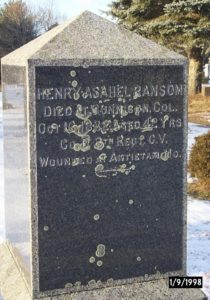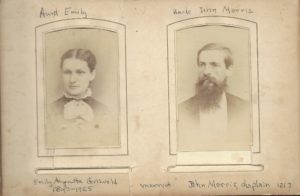#22,000
26 May 2024
The Antietam on the Web database is now up to 22,000 individuals.
The entry getting us to that number is for the man under this impressive stone in Colchester, CT: Henry A Ransom, late Corporal, 8th Connecticut Infantry. He was seriously wounded in the knee at Antietam in September 1862 and troubled by it for the remaining 20 years of his life.

[photo by the late Frank Grimes for Find-a-grave]
Onward!
Lt. Jacob Eaton (1862)
15 May 2024
The Reverend Jacob Eaton was a Congregational minister in Meriden, CT before the war and enlisted in the 8th Connecticut Infantry as a Private soldier in September 1861. He was appointed First Lieutenant in February 1862 – and probably sat for this photograph soon after.
He was wounded in the leg at Antietam in September 1862 and resigned his commission in October, but returned to the field as the Chaplain of the 7th Connecticut Infantry in 1864. He died of disease in Wilmington, NC in March 1865.
This fine photograph is in the collection of the Connecticut Museum of Culture and History in Hartford.
Emily A Griswold and John M Morris (c. 1863)
14 May 2024
Emily Griswold and John Morris were probably engaged before he left New Haven for service as Chaplain with the 8th Connecticut Infantry in April 1862 and they married in December 1863, about three months after he returned home.
Emily was from a large and prominent Connecticut family, her father a successful farmer at Wethersfield, near Hartford.
Here she is in her wedding dress:
I think it’s safe to say her husband was not the same man she knew in New Haven in the Spring of 1862, fresh out of Yale Divinity School.
At Antietam, in particular, he’d been through some harrowing combat. He was with his regiment out in front of the Federal Ninth Army Corps in the advance above the Rohrbach (later Burnside) Bridge, nearly reaching the town of Sharpsburg by about 5 pm on 17 September 1862. Earlier in the day he assumed the typical Chaplain’s role of assisting wounded men to the rear, but by the end he’s picked up a rifle and “fights for life” himself.
Sadly, Emily became a young widow in 1873 when John died of tuberculosis at age 36.
Notes
These photographs are from the Cabinet Card Album of Mary Helena Griswold, wife of John Leslie Welles, now held by the Welles Family Association, Wethersfield; shared to the FamilySearch genealogical database by Barbara Mathews.



